Discover ten weeds with purple flowers that can support pollinators and add color to your yard.
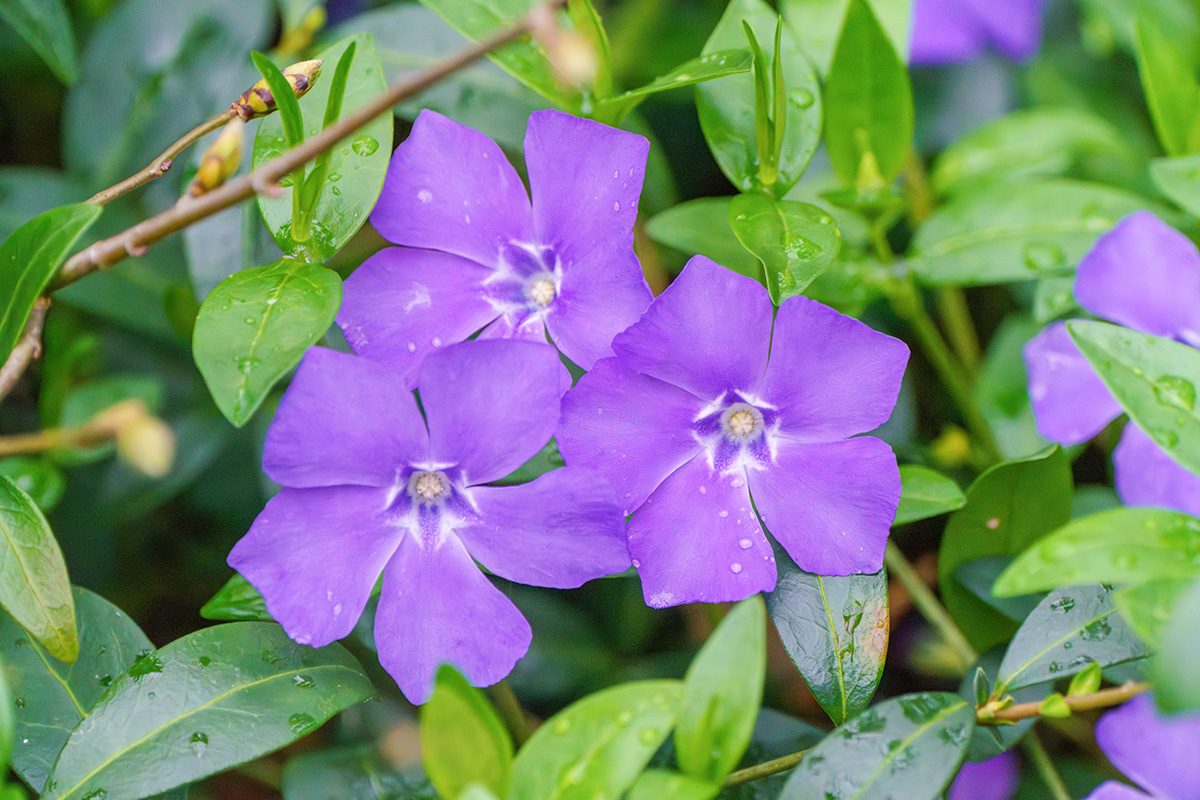
10 Weeds With Purple Flowers

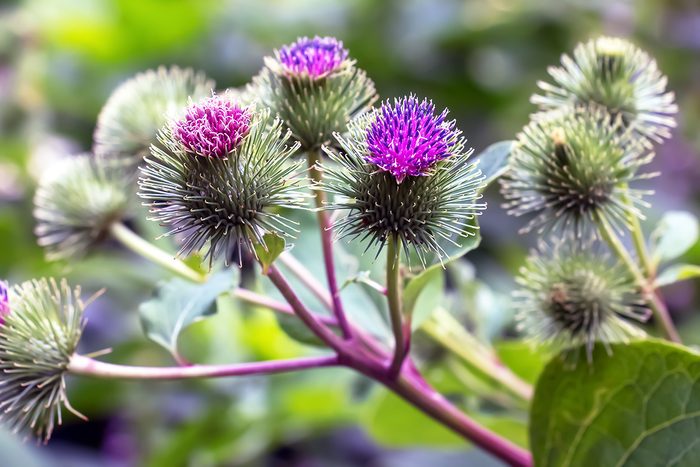
Burdock
With large, rough-textured leaves, burdock has distinctive, fast-growing foliage and pretty purple or pink flowers that look like thistles. The flowers later turn into burrs that cling to animals and clothing, helping the plant to spread prolifically. Growing to 4 to 5 feet tall in a single season, burdock is “considered invasive in North America, especially in the Pacific Northwest and Midwest,” Singh says. Manual removal is the best way to control burdock in your garden.
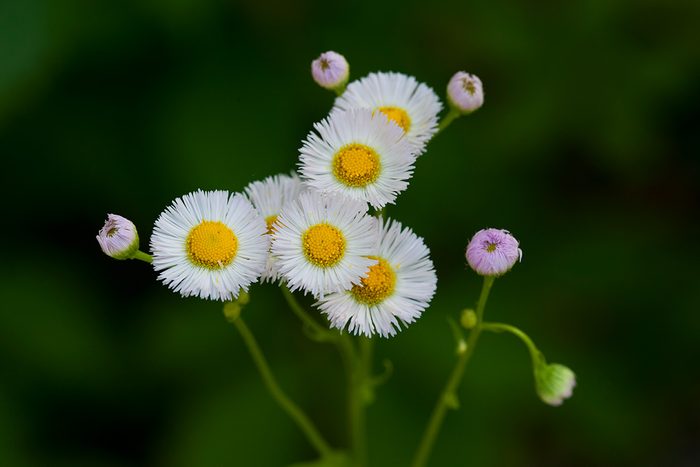
Fleabane
Fleabane resembles miniature daisies with their small purple, pink or white petaled flowers with yellow centers and long, narrow pointed leaves. Fleabane can be found in fields and roadsides, where it can rapidly spread and form clusters, especially in full sun. While not overly aggressive, fleabane will need management in a garden setting to control its spreading habit.
Besides its pretty purple flowers, fleabane can also be used as a bug repellant. “The leaves release compounds that are believed to help keep unwanted insects at bay,” Singh says. “It has been used to deter pests, including fleas (thus the name).”

Wild Violet
A low-growing ground cover, wild violet has heart-shaped leaves and small purple or white flowers. Violet can be quite invasive in lawns and garden beds. “Since they are perennials and readily produce large amounts of viable seed, these plants can become problematic and remain that way for quite a while if not managed early on,” Schmitz says. “Control can be difficult, depending on your comfort level with using chemicals.” I’ve found broadleaf weed killer to be the most effective method for controlling wild violet in my lawn.
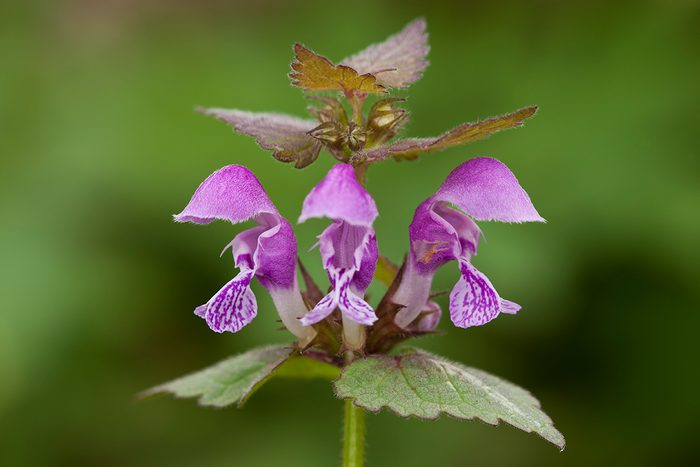
Purple Deadknettle
Purple deadknettle produces small purple flowers and jagged, heart-shaped leaves that emerge from a single, central stem. Part of the mint family, it is a low-growing plant of 2 to 8 inches. One of the earliest plants to emerge in the spring, purple deadknettle is also an important food source for pollinators. “These plants are easily controlled via hand weeding in beds and rarely become an issue in turf because they are intolerant of mowing heights,” Schmitz says. “If you can tolerate them early in the season, it wouldn’t be a bad thing to let the bees have their fill before pulling these plants as other flowers come into bloom.”

Chicory
Often found in fields, meadows and along roadsides, chicory can be an attractive addition to a wildflower garden as well. Drought-tolerant and low-maintenance, it has delicate stems with purplish-blue, daisy-like flowers.
Chicory is considered an invasive plant in parts of the U.S. and can quickly take over if not carefully managed. “This stuff appears all over the place here in Maryland, where I live,” Singh says. “I see it pop up in different areas of my yard, near the driveway and along the road throughout the state.” Chicory also has medicinal properties and can be used as a coffee substitute.

Creeping Speedwell
This fast-growing ground cover produces small, purplish blue flowers on delicate stems. The opposite-oriented leaves have a rose-bud appearance on new growth and can be an attractive addition to a garden. Considered invasive in some states, creeping speedwell can become problematic if not closely tended to. It is very hardy and drought-resistant, and will grow in large patches reaching 3 feet wide.
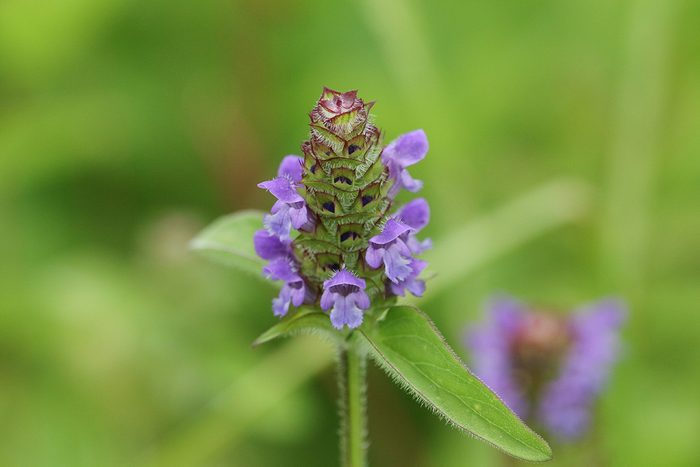
Heal-all
Heal-all produces tall, cone-shaped clusters of small, purple or pink flowers on the top of single stems with oval, serrated leaves. A low-growing plant, the flower stems stand a bit taller than the foliage, at 6 to 12 inches. An attractive addition to gardens, Heal-all is a spreading ground cover that will need to be managed to prevent a takeover. “If left unchecked, this plant can form masses of plants and stolons stretching out along the ground. It can be pulled by hand, but it is a laborious task,” Schmitz says. “Chemical applications are able to control this plant rather effectively.”
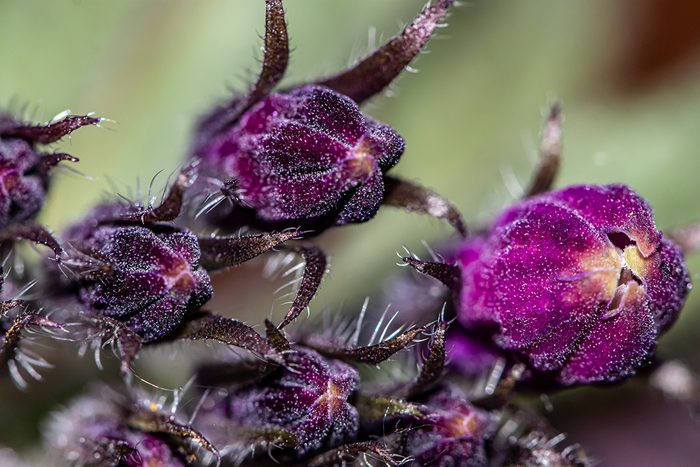
Comfrey
With thick foliage consisting of spear-like, broad leaves, comfrey can be quite a presence in a garden, reaching heights of 2 to 4 feet. The real draw, however, is the clusters of drooping, bell-shaped purple, blue or pink flowers. If you want to add this to your pollinator garden, it will reach full size in a single season. However, it can be difficult to manage once established. Comfrey can thrive in less than ideal soils, and is drought-tolerant due to its deep tap taproots so it can be difficult to remove.

Aster
Another weed with purple flowers that is great for pollinators, asters produce small, star-shaped purple or white petaled flowers with yellow centers. They have slender, delicate leaves and stems with a clumping growth habit and can grow 2 to 4 feet tall. While not a rapid grower, once established Aster will spread through underground rhizomes. However, aster is a manageable plant in gardens, only requiring occasional splitting and cutting back.

Ground Ivy
Also known as Creeping Charlie, this opportunistic ground cover is commonly found in lawns and disturbed soil. Ground ivy produces small, purplish blue flowers and has foliage that mimics the look of clover. “It has the same square stems and attracts pollinators like other mints do, but there are few other redeeming qualities about this plant,” Schmitz says. “It crawls across the ground, rooting as it goes, creating an insidious sprawling mass of vines.” Manual removal and targeted broadleaf herbicide applications are the best methods to control this weed in beds and lawns.
About the Experts
- Samuel Schmitz is a full-time faculty instructor in the Horticulture Department at Triton College in Illinois. He was formerly Ground Operations Supervisor for Ball Horticultural Company for 16 years.
- Trisha Singh is the Vice President of Product at Garden for Wildlife, a program run by the National Wildlife Federation, which encourages wildlife-friendly gardening spaces. Trisha is a wildlife biologist who enjoys native plant gardening and helping to support others in their native gardening pursuits.
Sources
- Clemson College of Agriculture, Forestry and Life Sciences, “Heal-all“



















